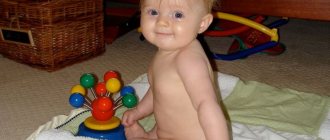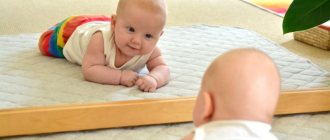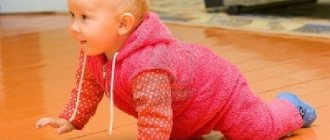Photo: UGC Sometimes parents are so impatient: they want the child sit up, walk and faster . However, no need to rush things: everything has its time. Some mothers and fathers begin to worry if the baby does not start doing something on time . To avoid panic, we will tell you when a child begins to crawl and sit.
When a baby starts to crawl: what is “crawling”
The baby does not immediately begin to crawl. At first, the baby crawls on its belly or on its stomach; this movement can appear at 6 months or earlier. But this is not crawling. This movement is called "creeping."
“Proper crawling” is crawling on all fours, not pulling yourself up on your hands.
If a child only pulls himself up on his arms and does not get on all fours, then his legs do not participate in the movement and subsequently lag behind in development.
In correct crawling, the baby’s opposite arms and legs move simultaneously
(right leg and left arm, then left leg and right arm), which develops the baby’s brain and requires good coordination of movements and a sense of balance.
It is this movement of the baby that is called “crawling.” And it is precisely this kind of crawling that is extremely beneficial for the overall development of the child.
Cause for concern
In some cases, parents are not able to cope without the help of specialists (neurologist or orthopedist). Here are a few key points that should alert you and be a signal to immediately consult a doctor:
- By eight months, the child does not even make weak attempts to crawl. Doesn't rise on its arms and doesn't try to move its whole body forward.
- When learning to crawl, the baby stays at one stage for too long (more than a month) (for example, he learned to swing on all fours and stopped there).
- An eight- to nine-month-old baby crawls, pushing off with his legs, but without lifting himself up on his arms, or crawls, lifting himself up with only one arm, and simply drags the other along the floor. At the same time, during the game he uses both hands.
- The child crawls only backwards. Many children first learn to crawl backwards and only then forwards. But if a one-year-old baby, trying to take independent steps forward, continues to crawl exclusively backwards, this is a serious alarm signal.
The importance of crawling for child development
Why is crawling so important for a baby and why is it important for us, adults, to create all the conditions for the development of crawling:
First. Crawling at the age of 6-10 months strengthens the muscles of the arms, legs, back, abdominals, and neck. Crawling, in its essence, is the baby’s first form of independent movement. Having learned to crawl, the baby begins to sit up and stand up on his own, walk with support, step along the barrier in the crib, and change his position.
It has been noticed that children who begin to crawl in a timely manner and crawl actively, as a rule, then learn to sit down and stand up more easily and quickly (note: not “sit”, but “sit down and stand up”, this is a more important movement for a child), lie down, stand up and down, holding onto a support, stand.
Second. Crawling has a positive effect on the formation of correct posture and is a prevention of flat feet. Therefore, it is important that the child learns to crawl before sitting or standing on his feet.
Third. While crawling, the child becomes more independent and active, gets acquainted with the properties and qualities of objects, his life experience and horizons expand, and his orientation in the environment around him is formed. This promotes good mental development of the child. In addition, a crawling child becomes much more active and learns to achieve desired goals.
According to research by T.L. Goddess, a child’s health is determined by his physical activity. Among children with health problems, 50% have low motor activity, 30% are lagging behind in the development of basic movements. Moreover, physical activity affects not only the physical development of the child, but also his overall development.
The more diverse the baby’s movements, the richer his motor experience, the more information enters the baby’s brain, the better he will be developed, including intellectually (Shchelovanov N.M., Kistyakovskaya M.Yu.)
Fourth. Crawling actively and harmoniously develops the baby’s brain and the interaction between the right and left hemispheres of the brain. Because while crawling, the child’s opposite arms and legs move simultaneously (he moves his right arm simultaneously with his left leg, and his left arm with his right leg). That is why crawling is not easy for a child, as it requires good coordination of movements.
As you can see, crawling is a movement that is vital for a baby for its harmonious development. When and how does crawling appear in a child’s life, and why do many children now not crawl, but immediately stand on their feet and begin to walk?
About the benefits of crawling
Crawling is an important stage in a baby's development that should not be missed. Moreover, neurologists believe that crawling has a much greater impact on the further development of the child than the first step. It is during the period of crawling that precedes the first steps that the relationship between the right and left hemispheres of the brain is established. In children who began to crawl early, both hemispheres of the brain are developed, and the predominance of one over the other is insignificant. Early “sliders” are distinguished by their comprehensive development and success, both in the humanities and in the exact sciences.
In addition, at 8-9 months, crawling provides the most optimal distribution of physical activity. The fact is that the emotional and psychological state of the baby is closely related to physical activity. The work of muscles maintains the tone of the central nervous system: the less the child moves, the more passive his perception of the world around him, the more insecure he feels. Hence, in the future, emotional instability, isolation and lack of initiative appear. In medicine there is even such a term - “muscle hunger.” This is when, due to insufficient mobility and passivity, the child may experience physiological disruptions in the body. With insufficient muscle load, the development of the musculoskeletal system, cardiovascular and endocrine systems slows down, blood circulation worsens and metabolism is disrupted. By the way, sedentary children have much lower immunity, they often get sick and have a hard time even with a mild cold.
When does a baby start to crawl: crawling development calendar
In the first months of life, a baby experiences the so-called “crawling reflex . Sometimes you can see messages on YouTube and social networks that they – modern babies – are already crawling, although they have recently left the maternity hospital. This is not crawling! This is just a reflex that any healthy baby has.
How does this crawling reflex manifest itself? If a newborn is placed on his tummy (from the third to fourth day of life), then in this position he will begin to crawl, that is, make crawling movements with his body. If you place your palm on his soles, the baby will reflexively push off with his legs and crawling will intensify. Coordination of the movements of the arms and legs in the baby is not observed.
This crawling reflex is used to develop the muscles that extend the legs in children from one and a half to 3 months.
The crawling reflex is observed in the first months of the baby’s life and exists until the fourth month of the child’s life, then it should disappear.
How does real crawling appear in a child? This process takes several months.
By the end of the first half of life (at the age of 5 months)
the baby can lie on his stomach for a long time, leaning on his palms; press your feet firmly with the support of your armpits. And also rolls over from back to stomach.
In the sixth month of life, crawling develops
- a preparatory movement for crawling.
What is “creeping” - let's clarify the meaning of this word. A child at this age can spread his straightened arms (if they are already stronger) and, leaning on his palms, raise his body. If he sees an interesting toy in front of him, then he tries to pull himself closer to this object that interests him. To help your child crawl, you can create support for his feet. For example, place your palm under his feet as a support. Or use a roll made from a blanket.
From 6 months of age
in the position on the stomach, the baby raises his head high, turns it to the sides, leans on outstretched arms, easily transfers the center of gravity from one hand to the other, and reaches for the toy. Gets on all fours.
At 6-7 months
the baby turns over from his stomach to his back and crawls a little forward, sideways or even backwards. He persistently tries to get closer to the toy he likes.
These are the basic prerequisites for the further development of crawling.
If a child at 5-6 months lies on his tummy a lot, he will quickly learn to crawl, and then stand up and sit.
Crawling movements usually first occur in a child when he, lying on his stomach, tries to reach a toy lying in front of him.
This is important to know: Crawling is healthier than sitting.
After all, sitting, the child gets tired quickly. In the “sitting” position, having dropped a toy, he can no longer reach it, no longer wants to lie on his stomach while awake and demands to be seated.
By 7 months
The baby can already crawl. At first, the baby most often crawls backwards or in a circle. Then you need to lure him with a toy, he will soon learn to crawl forward, as well as crawl onto a hill and slide down from it. Teach your baby at the age of 7 months to crawl onto a small elevation (a flat foam pillow on the floor) and slide down from it. You will find games for this in the continuation of this article (see the link at the end of this article).
At 8 months
The child crawls a lot, quickly and in different directions. At 7-8 months, the baby crawls to the toy (located at a distance of 1-2 meters from him) immediately or with a short rest - distraction. He crawls in any way (of course, the most useful is crawling on all fours), changing the direction of crawling.
From 8 months, the baby can crawl not only on a flat surface, but can also crawl up the steps of a small children's slide to a small height or crawl onto a flat pillow lying on the floor.
Please note: these standards are indicative and are designed for children with whom they do gymnastics daily or at least systematically at home and for whom all conditions have been created at home for the development of crawling. For example, there may be such a situation: the child was never given the opportunity to crawl on the floor, he was constantly in a crib, in a playpen or in the arms of adults. They didn’t do gymnastics with him. The baby also did not have the opportunity to practice crawling onto a flat hill. Such a baby is absolutely healthy from birth, but, of course, will not be able to climb a slide at 8-9 months, as stated above, because simply has no experience with such movements! He won’t do this not because he has problems and needs medication, but because no one has simply dealt with this with him. Most likely, such a baby will immediately move on to standing up and walking, bypassing the crawling stage. What to do in this case? Gymnastics and motor games will help give this baby the necessary and vital experience of movement and motor activity. And he will quickly learn everything with your help.
In connection with this example, the following question arises: does crawling arise on its own as a result of the maturation of the child’s brain or does it require our help in development? Let's figure this out. This is very important to understand, because children are often compared based on their ability to crawl as an indicator of their level of development. But this is not so!
Security measures
To assess the situation, you should get down on the floor and look around the house through the eyes of a baby. It is worth paying attention to the following points:
- Temperature. If there are small drafts, it is necessary to dress the child in warm, but not restrictive clothing.
- Sharp corners, falling objects. To prevent your baby from hitting the sharp edges of the furniture, you need to cover them with special silicone pads. Cabinet doors can also be opened by a novice explorer, so they need to be secured with locks or safety hooks.
- Height. If a newborn crawls on an adult's bed, he or she may fall and be injured.
- Electricity. Electrical appliances should be kept out of reach of the baby. The wires must be removed under the shields, and plugs must be installed in the sockets.
- Objects that can be put in the mouth. The baby explores the world using as many senses as possible. If there is a flower pot, household chemicals, trash can or cosmetics on his way, he may lick it all or even try to eat it.
- Purity. Do not use products that kill germs. The baby will have to live in a non-sterile world, so for the proper formation of his immune system, a simple wet cleaning is enough.
- Pets. A baby can hurt pets, and not every animal will react to such an attack leniently, so at first you should allow your newborn to have contact with cats and dogs only under adult supervision. It is important to comb the animals in a timely manner so that the baby does not swallow their hair and treat the pets with anti-parasite products.
When a child begins to crawl: is it necessary to teach the baby to crawl and do gymnastics?
For a long time, people believed that a child's mastery of movement in the first year of life was solely the result of brain maturation. And adults only need to provide food and hygienic care for the baby.
However, M.Yu. Kistyakovskaya’s study of the development of movements in children of the first year of life proved that the pace and sequence of movement development depend on the child’s living conditions and the interaction of the people around him with him.
We teach a child to crawl and perform special gymnastics with him not for the sake of the fact of “crawling or not crawling,” but for the sake of the harmonious and complete physical and general development of the child and the prevention of serious diseases in the future.
Children with whom adults have systematically practiced gymnastics since birth have better posture, good coordination of movements, speed, dexterity not only in outdoor games, but also in everyday activities, rapid mastery of all basic types of movements (running, walking, jumping, climbing, rolling, throwing and catching, throwing). Poor muscle development in infancy leads to poor posture, flat feet and other problems in the child’s health in the future (Golubeva L.G.)
As we see, the development of crawling and its improvement in a baby will largely depend on our correct tactics in raising the baby, on whether the adults did daily gymnastics with the child, whether they created conditions for crawling at home, and whether they communicated correctly with the baby.
What if the child did not crawl, but walked right away?
There are no dogmas in medicine. If your child goes past the active crawling stage, this is his right. However, in this case, he will definitely get his way during outdoor games. Remember - at 3-4 years old and even in preschool age, many children's games involve crawling. Mothers do not have time to darn tights on their knees or buy new ones. Don't scold your baby - he needs it. Such playful crawling will successfully replace “developmental activities” for the baby, as it has a multi-component effect and is in every way more useful than sitting motionless in the office in the company of an unfamiliar aunt.
When does a baby start crawling: individual differences in crawling
If a baby has learned to get on all fours by the age of six to seven months, then he usually immediately begins to crawl, leaning on his hands and knees (“correct crawling”). If the baby has not yet gotten onto all fours, then first he will crawl on his stomach, and only then will he master crawling on all fours.
Usually children at 8-9 months are already crawling on all fours, but there are children who do not crawl on all fours at all, but immediately pull themselves up, stand on their legs, move along the support and then begin to walk.
All babies crawl and start crawling differently. Some babies start crawling backwards or sideways and may take a few days or weeks to start crawling forward. Other babies glide on their buttocks or on their knees with support on their palms, and only then move on to crawling on all fours. Or they don't transfer. There are children who, having started crawling on their bellies, never switch to crawling on all fours and immediately begin to stand up and walk.
Usually, if the baby is systematically doing gymnastics at home and there are conditions for crawling at home, then he masters crawling on all fours without problems and crawls actively. After all, it is most useful for a baby to first start crawling and then stand on his feet.
The timing of mastering crawling does not in any way affect the timing of mastering walking. An actively crawling child may go late. A baby who crawls little can start walking early.
Many babies don’t crawl only because they don’t have the opportunity! They are constantly in a stroller, crib or playpen or on a sofa surrounded by chairs for safety, and they do not have the opportunity to practice the ability to get up on their knees and hands and try to coordinate their movements and crawl to an object of interest to them. Such children immediately stand on their feet and begin to walk.
THIS IS IMPORTANT TO KNOW: You need to remember that it is healthier for a child when crawling appears before walking and sitting. If a child begins to sit and walk without crawling, then his muscular system is not yet ready to hold the body in an upright position. As a result, asymmetric loads arise on the joint-ligamentous apparatus and thereby create the preconditions for poor posture in the future.
main rule applies it is more important and expedient for the child to first master motor functions (this is moving the body in space, and crawling refers specifically to the motor function), and only then – static functions (maintaining one position body for a few seconds, for example, sitting in a motionless position). Therefore, it is more important to teach children not to sit, but to crawl, and then to sit down; teach not to stand, but to stand up.
Eight factors of “non-creeping”
Before you begin to develop crawling skills, you need to find out why the child does not attempt to move on all fours. Experts identify eight factors that hinder the development of crawling.
- Underdevelopment of muscles or weakness of the musculo-ligamentous apparatus
(for example, as a result of rickets).This diagnosis is made by a pediatrician during regular examinations. He also prescribes appropriate treatment and massage. If you ignore your doctor’s advice and independently develop your child’s crawling skills, this can lead to serious injuries to ligaments and muscles.
- Overweight
.The children's skeleton is still very weak and is not able to withstand the load of excess weight. An overfed, “obese” child lags behind in physical development, sits up later, and later begins to crawl and walk. It is simply difficult for such a child to move.
- Prolonged stay in bed
(as a result of illness).Children who were sick a lot in the first six to eight months of life often lag behind in physical development. In this case, you should not rush things. Having grown stronger, the child will quickly learn to crawl.
- Limb injuries
.If there are broken limbs, sprained ligaments, or severe bruises, it may be painful for the child to crawl. In this case, you will need the help of an orthopedic doctor and massage therapist.
- "Tight swaddling"
.Being in comfortable blouses and rompers from the first days of life, the child learns to feel his body earlier, moves more and, therefore, begins to crawl earlier. If you are a supporter of “tight swaddling” or it is recommended for your child for medical reasons, place your baby without diapers as often as possible. It is necessary to provide the baby with freedom of movement from birth.
- Prolonged stays in a playpen or walker
significantly slows down the development of crawling skills.Of course, you shouldn’t give up on a life-saving playpen or walker. The most important thing here is not to abuse it and not lock your baby behind a net for the whole day. A child under one year old should not be in the playpen for more than two hours a day and preferably no more than 30-40 minutes at a time. The same goes for walkers.
- Hereditary predisposition
.Experts have found that the norms of physical development are inherited, with boys most often developing like their fathers, and girls being like their mothers. For example, if dad first walked, and only then learned to crawl, there is a high probability that his son will follow his example. So before you complain about your child, ask your parents about how you developed.
- Laziness, lack of interest
.Laziness is an innate quality. Only some kids are too lazy to crawl, while others are too lazy to play with a rattle or listen to fairy tales. And the task of parents is to awaken in the child an innate sense of curiosity, which can overcome laziness.
When a baby starts to crawl: what factors influence a baby’s crawling and development
What should the crawling surface be like?
In order for a six-month-old baby to start crawling, you need to provide him with as much space as possible to explore (the floor). If the floor is cold, you can lay a large warm blanket on it. To crawl, you need a hard, large surface (not a table, not a crib, or a soft sofa). If a child spends most of his time in the arms of adults or in a crib, he will not strive to crawl, although he is healthy. It is in these cases that the child usually immediately stands on his feet without crawling and begins to walk, which is unfavorable for the development of the musculoskeletal system.
To induce the desire to crawl, in addition to a large hard surface, there should be bright, attractive toys around the child. But there should not be too many of them so that the child’s attention is concentrated on achieving the goal he desires.
How to properly use toys to develop crawling skills
— To develop crawling, use toys that meet three requirements:
1) they are new or clearly attractive to the baby,
2) the toy must be stable,
3) the toy should be comfortable for a child to grasp.
— At what distance from the child should you place toys?
a) First, the toys are placed at such a distance that, with outstretched arms, the child almost touches them with his fingertips.
b) If the child is already crawling a little, then the toy can be placed at a further distance (1 meter), then the distance can be gradually increased (up to 2 meters).
— In order for a child to crawl towards a toy, you need to draw his attention to the toy, for example, move it or make a sound. Sometimes, in front of the child’s eyes, you have to move the toy a little closer to the baby so that he begins to strive for it.
— How to help a child if he “doesn’t want” to crawl to a toy. Sometimes, even despite the baby’s great obvious desire to crawl towards the toy, he cannot begin to crawl. Or it crawls not forward, but back from the toy or to the side. Then you need to help the child. We place our palm on his feet (soles) so that he can push off from our palm. When the child pushes off and crawls a little towards the toy, move the toy a little. If the child does not push against your palm even when supported, then bend his legs at the hip joint and move them to the sides (the “frog” position), the legs are slightly bent and place your palm. The baby will push off from the palm. And so repeat 2-3 times, after which give the baby the opportunity to receive the joy of reaching the toy and examining it.
- After the baby has crawled to the toy, let him play with it as much as he wants and enjoy the result of his efforts.
— You cannot use rolling toys (ball, cart, car) to develop crawling, because they roll far away from the baby at the touch of his palm. And we need the child to be able, after crawling, to enjoy exploring the goal he has achieved - the desired toy. Such rolling toys like a ball can only be used when the child is already crawling, and we want to activate this movement that the child has already mastered.
— You need to know that the child will not crawl right away. And you shouldn’t expect this from him right away. At first, trying to reach the toy, he may even crawl backwards rather than forwards, and only after several attempts will he figure out how to move forward and coordinate the movements of his arms and legs.
- If a child crawls to a toy on his stomach, then you can “tell” him another way - on all fours. Place your hands under your baby's tummy and lift him up so that he is on all fours. Help him crawl forward, showing the toy a little ahead. Sometimes a wide towel placed under the baby’s belly is used for this.
How can you encourage a child to crawl towards a toy? Example game - activities
I was asked this question at one of the meetings with site readers, so I answer it in detail and give detailed instructions on how this can be done.
The entire game will take approximately 3 minutes at a time. It can be repeated daily with different toys and new objects.
Very important: during play, only the toy on display should be in the child’s field of vision. Place all other objects and toys away so that the baby does not see them. Also make sure that light from a lamp or the sun does not shine into the child’s eyes when looking at the toy. And try to make sure that nothing distracts him from the toy.
The first part of the game is activities. Demonstration of the toy.
Place your baby on his tummy. Place a toy - for example, a tumbler - at a distance of 20-30 cm from him. It is bright, and attractive, and sounds, and moves! Rock the tumbler to make it sound and sing the song. For example: “Ta-ta-ta, ta-ta-ta! What a beauty! Ta-ta-ta! Ta-ta-ta! Reach out to me” (lyrics of the song – V. Vetrova). Then show how the tumbler walks: “top-top-top”, how she sings “la-la-la”, how she swings “kach-kach-kach”. If you have another toy, arrange a similar demonstration with it.
After this, take a short break.
Second part. Child grasping a toy.
Most likely, your baby will reach for this toy during or after the demonstration. Praise him for this, pet him, say encouraging words. If the baby reaches out to the toy, but cannot reach it, then move the toy closer to the baby. And again repeat a small demonstration - for example, rocking a pile. Let the baby reach for it again and continue like this. When the baby can pick up the toy, let him play with it and rejoice at the achievement.
Repeat with different toys and your baby will begin to be active and understand that he can use crawling to achieve desired goals. Gradually increase the distance to the toy so that the baby can reach it not just by reaching or crawling, but by real crawling.
If you do daily gymnastics with your baby (about it in the continuation of this article), then place your hand as a support for the baby’s legs, he will push off from your hand and move forward towards the toy. He is already familiar with this movement from the “Frog” exercise. In the future, the baby will no longer require support, and he will learn to crawl without your help.
Crawling: preparing step by step
Crawling is a rather difficult process, for which the baby must be well prepared for all muscle groups and go through several important stages:
1)Keep your head up
. This one appears at the age of two to three months, when the baby lifts it while lying on its tummy. This skill can be considered the starting point for the formation of the vertical axis of the body - metamorphosis, during which a baby lying in a crib will begin to confidently stand on his feet and walk by his first birthday.
2)We lean on the handles
. This skill arises along with holding the head: lying on the tummy, the baby rests on his elbows, and by the age of four months, on open palms. This is what is needed to support the baby’s body weight on one arm while learning to turn, sit and crawl.
3)We turn over
. By the age of five months, the baby is already actively spinning: around itself, lying on the crib, from back to tummy and back. Finally, the little man is able to move in space, wanting to take possession of a bright toy.
4)We stand on all fours and sway
. The baby is so eager to move forward! Leaning on his palms and knees, he tries to move faster, but due to his “unruly” muscles, he can only achieve rocking movements in one place.
5)Let's crawl!
The baby has coordinated his movements, leaned forward and is persistently moving towards the new and unknown. The muscles receive the necessary load, the skeleton is formed correctly, and the nervous system is actively developing. This skill occurs in babies aged seven to nine months, but can be established at a later age.
Let's learn to crawl together!
In order for the baby to easily master crawling skills, closer to the age of six months, the main location should be the floor.
Not a playpen, a crib or a sofa, but a hard surface will be an excellent springboard for the full motor activity of a young researcher.
But before releasing the baby into “free swimming”, it is worth taking a number of preventive measures:
- wash and wipe the surface dry;
- examine it: it should not be cold, smooth, without grooves or splinters;
- if the floor is covered with carpet, make sure it does not slip;
- remove all small parts and dangerous objects from the floor and surfaces at the height of the child (raise curtains, hide wires, take flowers to another room, secure sockets with plugs, sharp corners with special silicone nozzles, tie drawers and doors with ropes). Once the space has become safe, lay out a variety of bright toys on the floor and let your baby go on an exciting journey!
And it’s even better to teach your child by example - sit next to him and show him a simple way to move.
How to help the baby?
If the child, according to the mother, is in no hurry to start crawling, then, of course, she wants to speed up this process. You can stimulate your baby in several ways:
- Exercises. These can be developmental exercises for the arm muscles, fitball exercises, and gymnastics.
- Massage. Up to a year, at different periods of a child’s development, three courses of professional massage of 10 sessions each are allowed. They are usually carried out after three months. But any mother can give a restorative massage to her baby herself at home.
- Incentives. All conditions for games and development must be created on the floor. It should be warm there and there should be enough interesting toys that may interest the baby.
- Provocation. Show with your example how to crawl. Show the child a toy that interests him so that he wants to reach for it.
- Imitation. It's no secret that younger children develop faster than older children, because they have an example to follow. If your child is the first-born, communicate with mothers of children of the same age or age, go to visit each other. Babies look at each other and try to repeat almost everything they see: sitting, crawling, taking their first steps and even going to the potty.
When to see a doctor?
It is important to remember that in order to prevent unpleasant consequences and correct possible disturbances in the child’s development, you should consult a specialist in a timely manner.
The reason to make an appointment may be cases when:
- by nine months the baby has made no attempts to crawl;
- does not move forward, does not rise on the handles;
- after ten months, the child crawls only on his stomach, rising only on one arm or not rising at all.
In such cases, consultation with a pediatrician, neurologist and orthopedist will help solve the problem and allow your baby to develop comprehensively and fully further day after day.
Along with the development of crawling skills, the baby turns from a passive observer lying in his mother’s arms, in a crib or on a development mat, into an active explorer of the world around him. Of course, parents eagerly wait for the baby to start crawling. At what age should one expect such an important skill to appear, is it necessary to help the baby, and how do children begin to crawl in general? We will try to answer these questions for you in this article.
Crawling is an incredibly important stage in a child’s development, because with its help, children not only strengthen their muscles and spine, improve coordination of movements, develop macro- and micromotor skills, but also learn to make decisions and, one might even say, think. When a child begins to crawl, this becomes a certain milestone in his perception of the external environment - after all, now the baby can reach on his own what he could previously only examine from afar. He learns to control his own body, while his brain develops comprehensively.
On forums you can often find some abstract figure - 6 months, supposedly the starting point for the development of crawling and sitting skills. But, believe me, there are so many options for their development.











